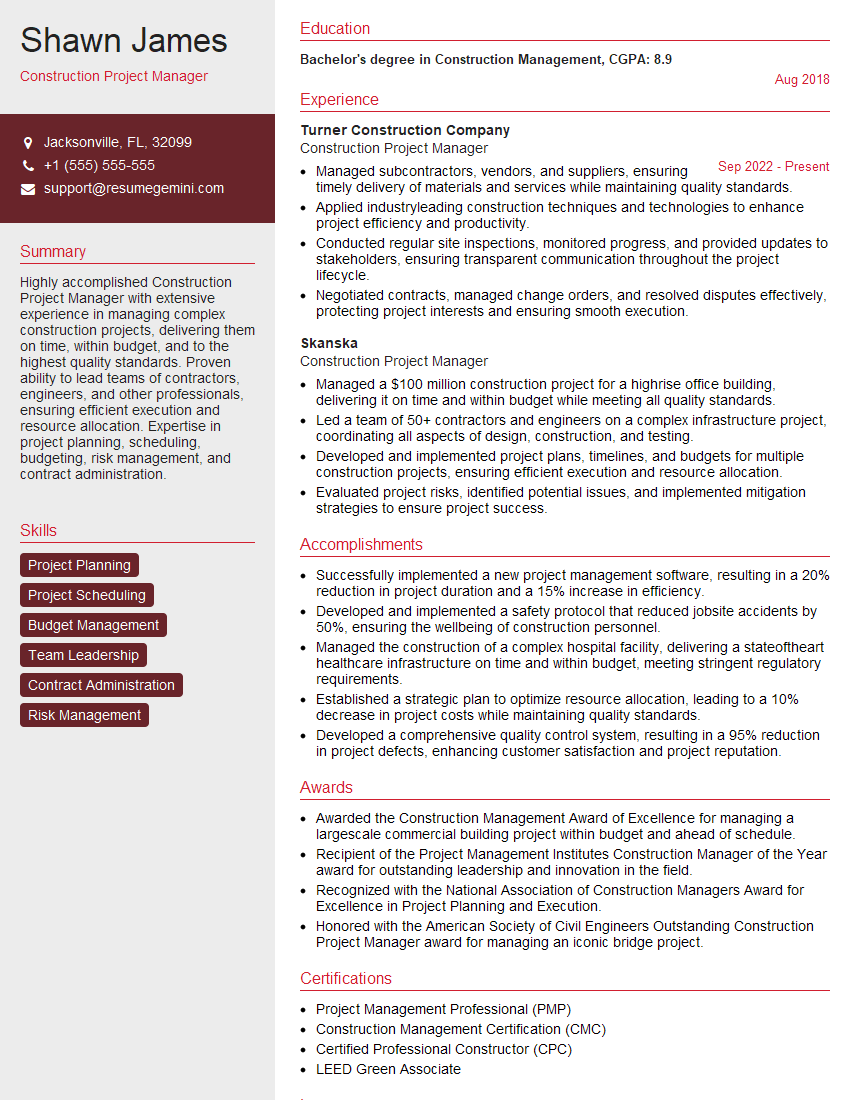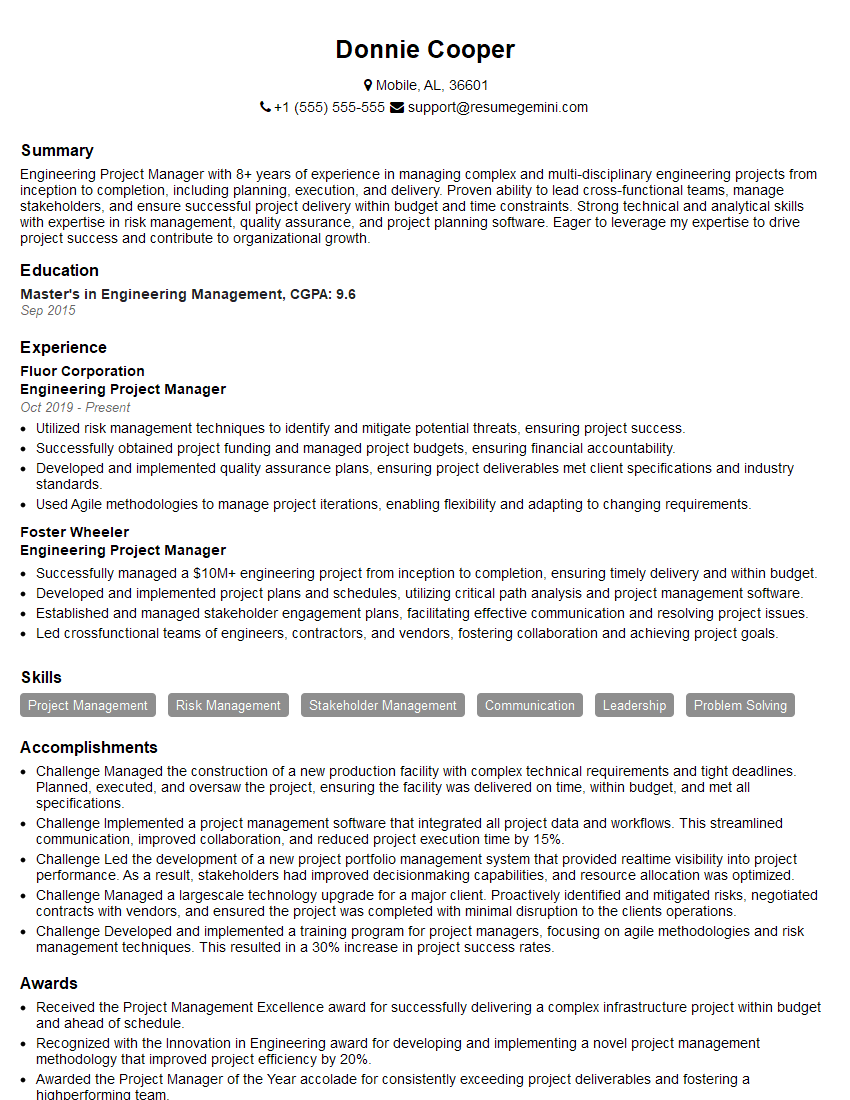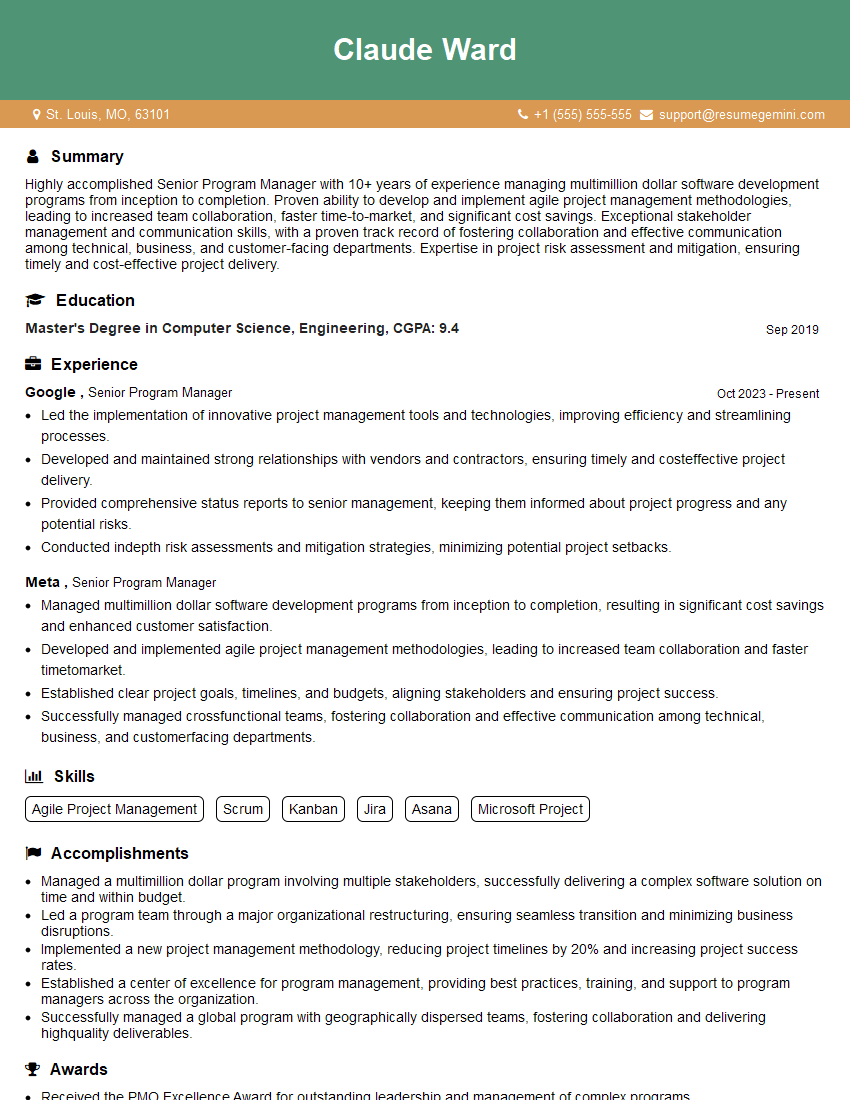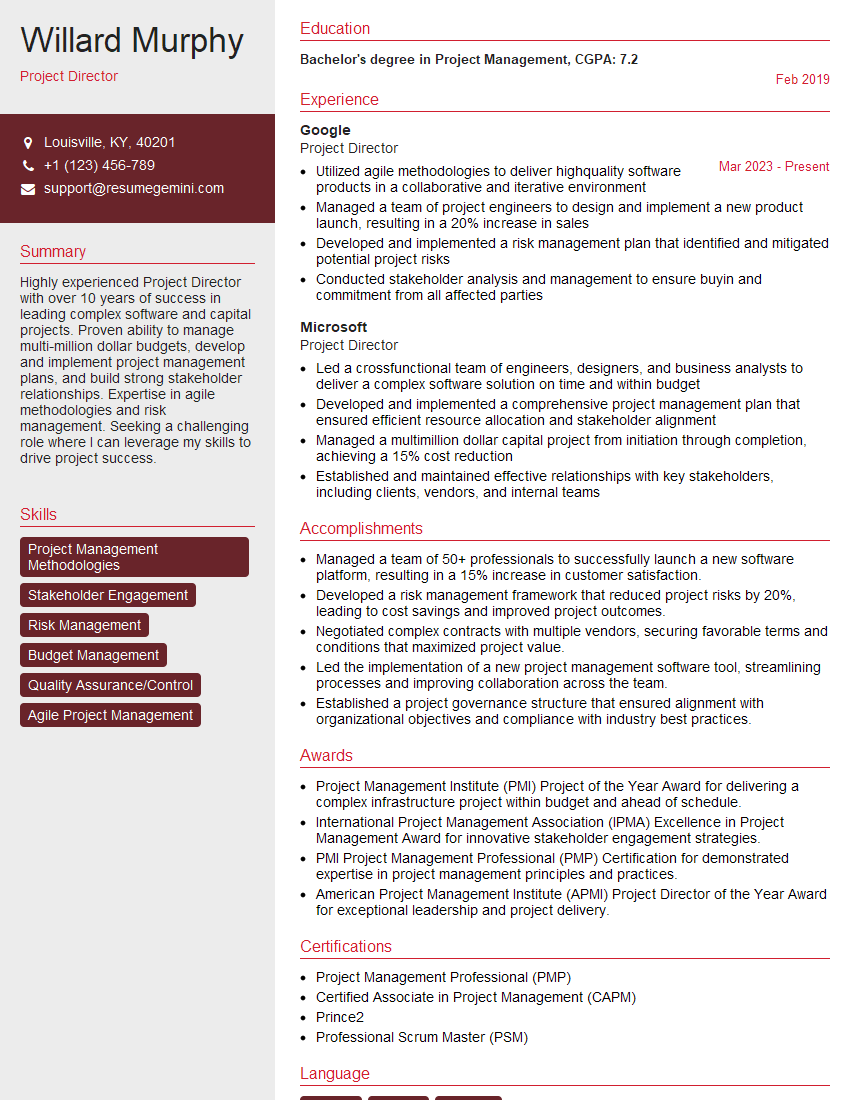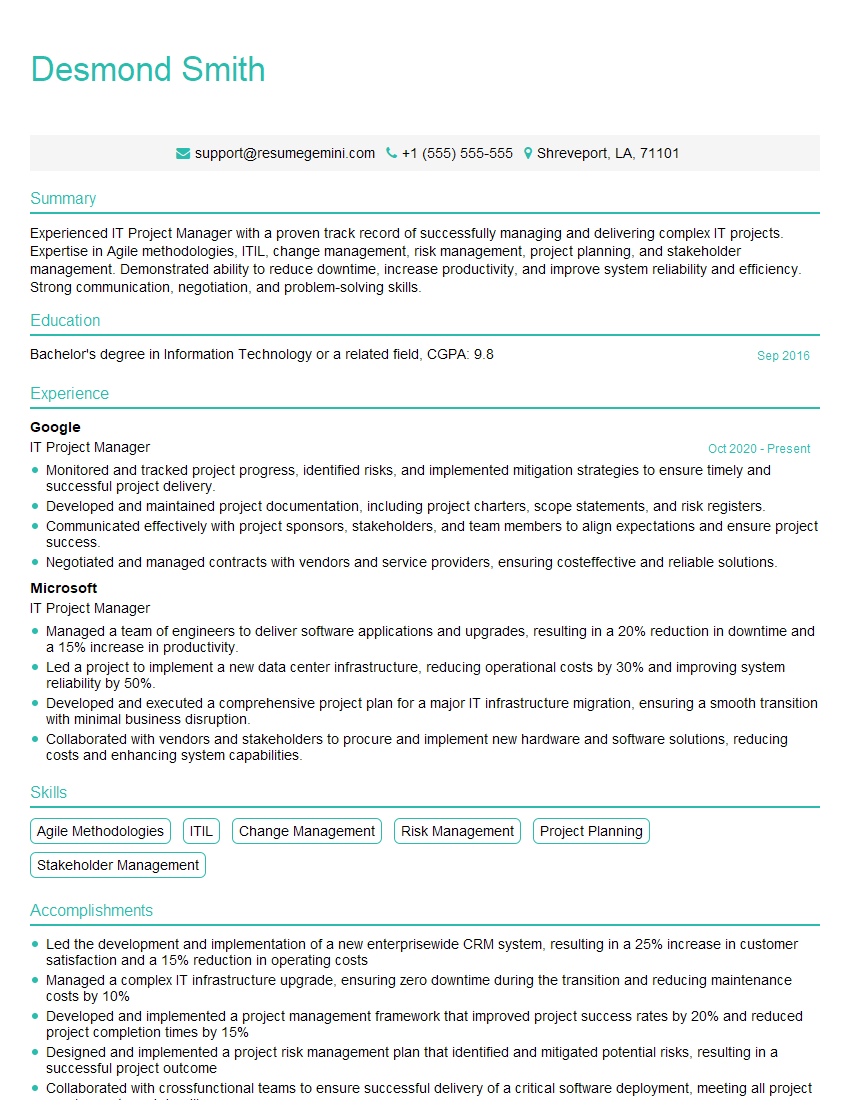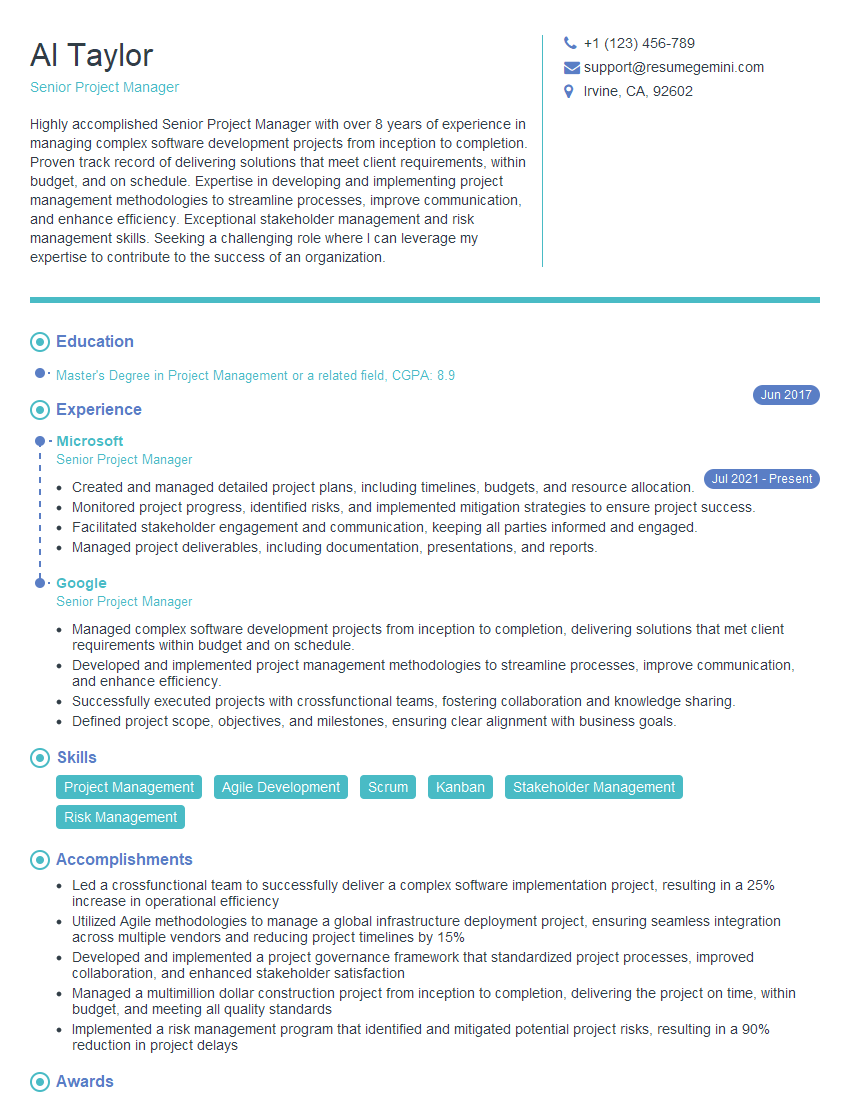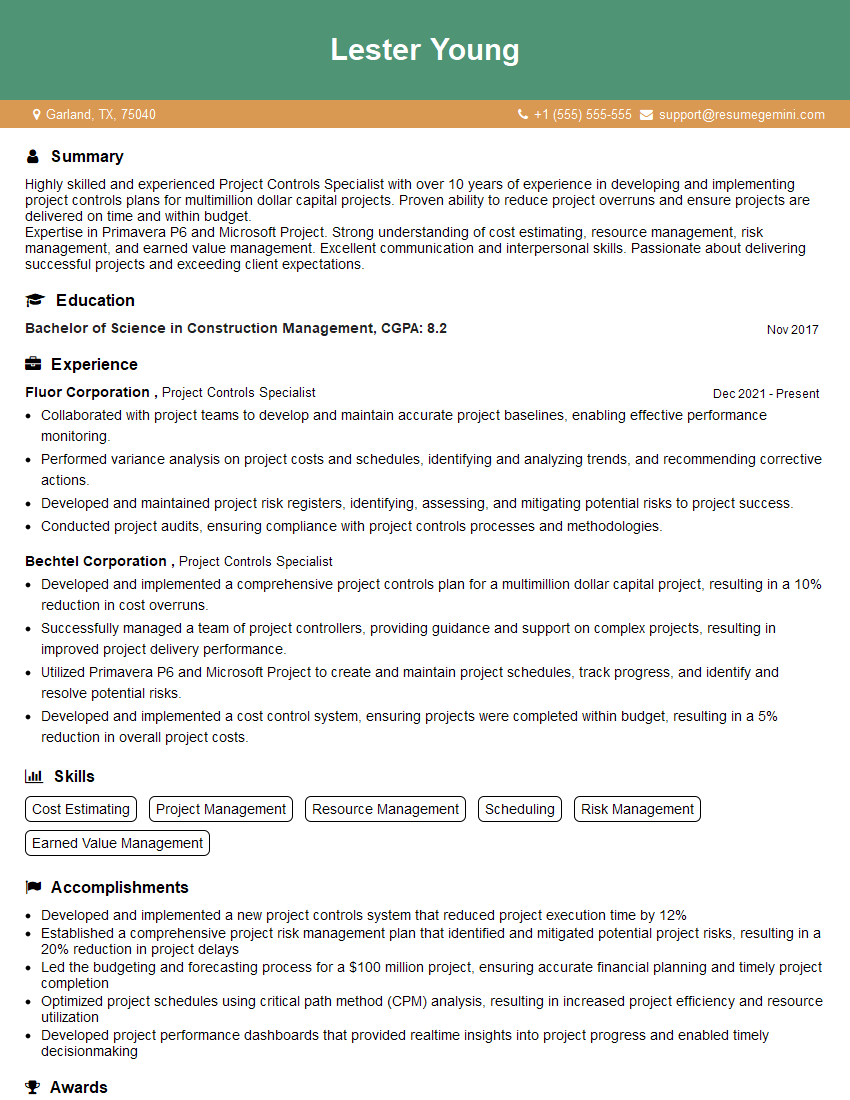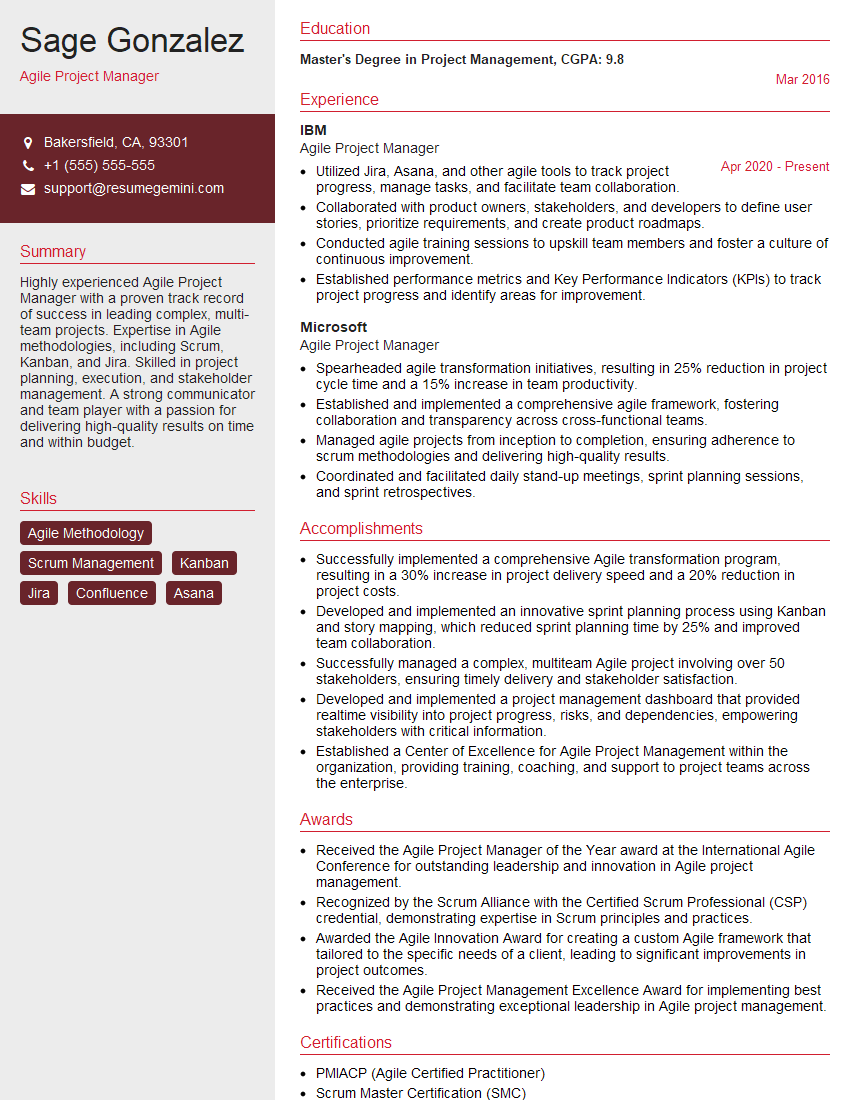Feeling uncertain about what to expect in your upcoming interview? We’ve got you covered! This blog highlights the most important Project Management (e.g., PMBOK) interview questions and provides actionable advice to help you stand out as the ideal candidate. Let’s pave the way for your success.
Questions Asked in Project Management (e.g., PMBOK) Interview
Q 1. Describe your experience with different project management methodologies (e.g., Waterfall, Agile, Scrum).
Throughout my career, I’ve successfully employed various project management methodologies, adapting my approach to suit the specific project needs. Waterfall, with its sequential phases, is ideal for projects with clearly defined requirements and minimal anticipated changes. I’ve used this on several large-scale infrastructure projects where deviations from the plan were costly and time-consuming. For instance, in a recent highway construction project, adhering to a strict Waterfall methodology ensured we met regulatory deadlines and stayed within budget.
Conversely, Agile methodologies, such as Scrum, are perfectly suited for projects requiring flexibility and iterative development. I’ve extensively used Scrum in software development projects, facilitating daily stand-ups, sprint planning, and retrospectives to ensure continuous improvement and responsiveness to changing client needs. A recent example involves a web application where client requirements evolved throughout development; Scrum’s iterative approach allowed us to incorporate changes smoothly and deliver a product exceeding expectations.
My experience extends to hybrid approaches, blending elements of Waterfall and Agile to achieve optimal results. This is particularly effective for projects with both stable and evolving aspects, allowing for a controlled level of flexibility while maintaining a structured framework. In one instance, I combined Waterfall for the foundational architecture of a new manufacturing plant with Agile sprints for the implementation of specific production lines, optimizing efficiency and minimizing disruption.
Q 2. Explain the difference between a project and a program.
While both programs and projects involve managing tasks and resources, they differ significantly in scope and objectives. A project is a temporary endeavor undertaken to create a unique product, service, or result. It has a defined beginning and end, specific goals, and a dedicated team. Think of building a house – it’s a project with a start and finish date, a defined budget, and a team dedicated to its completion.
A program, on the other hand, is a group of related projects, sub-programs, and program management activities managed in a coordinated way to achieve strategic objectives. It’s a collection of projects working towards a common, overarching goal, often spanning a longer timeframe. For example, a company’s initiative to expand into a new market might be a program encompassing multiple projects such as market research, product development, and marketing campaigns.
In essence, a project is a single, self-contained undertaking, while a program is a broader, strategic initiative composed of multiple projects.
Q 3. How do you prioritize tasks in a project with competing deadlines?
Prioritizing tasks with competing deadlines requires a structured approach. I typically utilize a combination of techniques, including:
- Prioritization Matrices: Methods like the Eisenhower Matrix (urgent/important) help categorize tasks based on their urgency and importance. This allows for focused attention on the most critical items first.
- Dependency Analysis: Identifying task dependencies helps determine the sequence in which tasks must be completed. Critical path analysis is a powerful tool for this, pinpointing the longest sequence of tasks impacting project completion.
- MoSCoW Method: This prioritization framework classifies tasks as Must have, Should have, Could have, and Won’t have, providing clarity on essential versus less critical tasks.
- Stakeholder Input: Collaboration with stakeholders to understand their priorities is crucial. This ensures alignment and avoids overlooking critical aspects.
By combining these methods, I create a prioritized task list that optimizes resource allocation and maximizes the chances of meeting crucial deadlines, even in the face of competing demands. For example, in a software development project with tight deadlines, I might use the MoSCoW method to identify core features (Must have) that must be delivered on time, while less critical features (Could have) might be addressed in subsequent sprints.
Q 4. What is your experience with risk management and how do you identify and mitigate risks?
Risk management is an integral part of my project management process. I use a proactive approach, starting with risk identification through brainstorming sessions, SWOT analysis, and reviewing past project experiences. This helps to uncover potential issues early on. For example, in a construction project, potential risks might include weather delays, material shortages, or labor disputes.
After identifying risks, I proceed to qualitative and quantitative risk analysis, assessing the likelihood and impact of each risk. This involves assigning probabilities and potential consequences to each risk. For instance, a minor risk might be a slight delay in material delivery, whereas a major risk could be a significant regulatory change impacting the project.
Finally, I develop a risk mitigation plan, outlining strategies to address each risk. This can involve contingency planning, risk transfer (insurance), risk avoidance (changing the project scope), or risk acceptance (acknowledging the risk and its potential impact). For the construction project, mitigation strategies might include securing multiple material suppliers, negotiating flexible contracts with subcontractors, or building in buffer time for potential weather delays.
Regularly monitoring and reviewing the risk register throughout the project is crucial to adapt to evolving circumstances and ensure risks remain under control.
Q 5. Describe your approach to stakeholder management.
My approach to stakeholder management is built on proactive communication and engagement. I begin by identifying all key stakeholders, understanding their interests, expectations, and potential influence on the project. This might involve creating a stakeholder register documenting their roles, communication preferences, and potential impact on project success.
Next, I develop a communication plan outlining how and when I will engage with each stakeholder. This includes regular updates, meetings, and tailored reports to address their specific needs and concerns. For instance, regular presentations to senior management may focus on high-level progress and budget, while more detailed reports for the project team may cover technical aspects.
I also prioritize building strong relationships with stakeholders through open communication, actively seeking their feedback and addressing their concerns promptly. This ensures their support and buy-in throughout the project lifecycle. Regular feedback mechanisms and open forums are effective tools for facilitating this engagement. Finally, managing stakeholder expectations is crucial; it’s important to clearly communicate project plans, constraints, and potential challenges from the outset.
Q 6. How do you handle conflicts within a project team?
Conflict is inevitable in any team environment, and I approach it constructively. My first step is to identify the root cause of the conflict, listening to all involved parties to understand their perspectives. This requires patience and active listening to avoid making premature judgments.
Once the root cause is understood, I work with the team to find a mutually agreeable solution. This might involve mediating discussions, facilitating compromise, or proposing alternative solutions. Depending on the nature of the conflict, I might utilize collaborative problem-solving techniques, encourage empathy, or refer the matter to a higher authority if necessary.
Throughout the process, I strive to maintain open communication and a respectful environment, ensuring all parties feel heard and valued. The goal is not simply to resolve the immediate conflict but also to build stronger working relationships and prevent future conflicts. Documenting the resolution and any agreed-upon actions is crucial for accountability and follow-up.
Q 7. Explain your understanding of the project life cycle.
The project life cycle is a series of phases a project goes through from its inception to completion. While the specific phases and their names may vary depending on the methodology (Waterfall, Agile, etc.), the fundamental stages remain consistent. A typical project life cycle includes:
- Initiation: Defining the project goals, scope, and feasibility.
- Planning: Developing a detailed project plan, including tasks, timelines, resources, and budget.
- Execution: Carrying out the project plan, managing tasks, and monitoring progress.
- Monitoring and Controlling: Tracking progress against the plan, identifying and addressing deviations, and managing risks.
- Closure: Completing the project, documenting lessons learned, and formally closing the project.
Understanding the project life cycle is crucial for effective project management. Each phase presents unique challenges and requires specific skills and attention. For instance, careful planning in the early stages can prevent major problems later on, while effective monitoring and control throughout the project ensures that it stays on track.
Q 8. How do you use project management software (e.g., MS Project, Jira)?
Project management software is indispensable for efficient project execution. My experience spans several tools, most notably MS Project and Jira. I utilize them to manage various aspects of a project, from planning and scheduling to tracking progress and managing resources.
In MS Project, I leverage its Gantt chart capabilities for visualizing the project timeline, assigning tasks to team members, defining dependencies, and monitoring critical path activities. I use the resource allocation features to ensure optimal team utilization and prevent over-allocation. The reporting features are crucial for generating progress reports and identifying potential bottlenecks. For example, I recently used MS Project to manage a large-scale software development project, successfully tracking over 100 tasks and 20 team members, resulting in on-time delivery.
Jira, on the other hand, is excellent for agile project management. I use its Kanban boards to visualize the workflow, track the progress of user stories (or tasks) through different stages (e.g., To Do, In Progress, Testing, Done), and manage sprints effectively. Its issue tracking and reporting features facilitate bug tracking, problem resolution, and continuous improvement. For instance, in a recent web application development project, Jira helped our team manage over 200 user stories, facilitating transparency and collaboration and leading to a high-quality product.
Q 9. Describe a time you had to make a difficult decision in a project.
During a large-scale website redesign project, we faced a critical juncture. The original deadline was looming, but unforeseen complexities in integrating a new e-commerce platform emerged. We had two options: Compromise the quality by rushing the integration, or request a deadline extension, potentially impacting our client’s marketing campaign.
After careful analysis of the risks and rewards – considering the potential impact on project quality, client relationships, and team morale – I chose to advocate for a carefully negotiated deadline extension. This involved transparently communicating the situation to the client, presenting a revised project plan, and highlighting the long-term benefits of a high-quality product. The client understood the rationale and agreed to the extension, ultimately leading to a successful project launch and strengthened client relations. This decision reinforced the importance of prioritizing quality and open communication, even when facing tough choices.
Q 10. What is your experience with budgeting and cost control in projects?
Budgeting and cost control are integral to successful project management. My approach involves creating a detailed budget breakdown at the outset, categorizing costs into direct and indirect expenses (labor, materials, software, etc.). I utilize Earned Value Management (EVM) techniques to track actual costs against planned costs, identifying variances early on. Regular monitoring of the budget is critical. I use tools like spreadsheets and project management software to visualize and analyze cost data, enabling proactive identification and mitigation of cost overruns.
For example, in a recent construction project, I implemented a rigorous cost control system, regularly tracking actual costs against the baseline budget. By identifying potential cost overruns early, we were able to renegotiate contracts with subcontractors, implement cost-saving measures (e.g., alternative materials), and stay within the allocated budget despite unexpected challenges.
Q 11. How do you track project progress and ensure projects stay on schedule?
Tracking project progress and ensuring projects stay on schedule requires a multi-faceted approach. I utilize a combination of techniques, including regular status meetings, progress reports, and the use of project management software. Visual tools such as Gantt charts and Kanban boards provide a clear overview of task completion and identify potential delays.
Regular status meetings facilitate open communication and identify roadblocks early. Progress reports, generated through project management software or spreadsheets, quantify progress against the project plan. Crucially, I employ techniques like critical path analysis to identify tasks that are critical to the project’s completion, allowing us to focus our resources and efforts effectively. For example, in a software development project, we utilized daily stand-up meetings to track progress, identify impediments, and adapt the plan as needed. This agile approach ensured timely completion.
Q 12. How do you measure project success?
Measuring project success goes beyond simply completing a project on time and within budget. It involves assessing whether the project achieved its intended objectives and delivered the expected value. I use a multi-dimensional approach, evaluating success against pre-defined criteria:
- Scope Achievement: Did the project deliver all the planned features and functionalities?
- Timeliness: Was the project completed within the scheduled timeframe?
- Budget Adherence: Was the project completed within the allocated budget?
- Quality: Did the project meet the required quality standards?
- Stakeholder Satisfaction: Were the stakeholders satisfied with the outcome?
- Return on Investment (ROI): Did the project generate the expected return on investment?
A balanced scorecard approach helps to ensure that all these aspects are considered. For example, for a marketing campaign, success was measured by lead generation, conversion rates, and brand awareness, in addition to cost and timeline metrics.
Q 13. What is your experience with change management in projects?
Change management is an inevitable aspect of project management. My approach involves establishing a formal change management process that includes a defined procedure for requesting, evaluating, approving, and implementing changes. This often incorporates a change control board to review proposed changes and assess their impact on the project’s scope, schedule, and budget.
Transparency and communication are key. Stakeholders are informed of proposed changes and their potential implications. Impact assessments help to quantify the effects of changes, and a revised project plan reflects approved changes. For instance, in a large software project, we implemented a robust change management process using Jira, which allowed us to efficiently track and manage over 50 change requests, minimizing disruption and ensuring the project remained on track.
Q 14. How do you handle scope creep?
Scope creep, the uncontrolled expansion of project scope, is a significant threat to project success. My strategy for handling scope creep involves a combination of proactive and reactive measures.
- Proactive Measures: A well-defined and detailed project scope statement is fundamental. Regular reviews of the scope statement throughout the project lifecycle are critical to identify and address any potential scope creep early on. Change control procedures, as described above, are crucial for managing any necessary changes to the scope in a controlled manner.
- Reactive Measures: When scope creep occurs, it’s important to evaluate the impact of the proposed change. This requires careful assessment of cost, time, and resource implications. If the changes are deemed necessary, they must be formally approved through the change control process, ensuring that any adjustments to the schedule and budget are appropriately reflected. If the changes are not critical to the project’s success, they should be documented for consideration in future projects or iterations.
For example, in a website development project, we used a robust scope statement and regular client meetings to identify and address scope creep before it became a major issue. This proactive approach helped maintain the project’s timeline and budget.
Q 15. Explain your understanding of Earned Value Management (EVM).
Earned Value Management (EVM) is a project management technique for measuring project performance and progress. It integrates scope, schedule, and cost data to provide a comprehensive view of project health. At its core, EVM uses three key metrics: Planned Value (PV), Earned Value (EV), and Actual Cost (AC).
- Planned Value (PV): The budgeted cost of work scheduled to be completed at a given point in time. Think of it as the planned budget up to a specific date.
- Earned Value (EV): The value of the work actually completed at a given point in time, measured against the planned budget. This reflects the value you’ve *actually* achieved.
- Actual Cost (AC): The actual cost incurred in completing the work up to a given point in time. This is simply what you’ve *actually spent* so far.
Using these metrics, we can calculate key performance indicators (KPIs) like Schedule Variance (SV = EV – PV), Cost Variance (CV = EV – AC), Schedule Performance Index (SPI = EV/PV), and Cost Performance Index (CPI = EV/AC). A CPI of less than 1 indicates we’re over budget, while an SPI of less than 1 indicates we’re behind schedule. EVM allows for early identification of potential problems and proactive corrective actions. For example, if the CPI is consistently low, we can analyze the reasons behind cost overruns and implement cost-saving measures.
In a recent project, implementing EVM allowed us to identify a cost overrun early on. By analyzing the CPI and investigating the reasons, we discovered an underestimated task. We re-evaluated the schedule and budget, implemented more efficient processes, and successfully brought the project back on track and within budget.
Career Expert Tips:
- Ace those interviews! Prepare effectively by reviewing the Top 50 Most Common Interview Questions on ResumeGemini.
- Navigate your job search with confidence! Explore a wide range of Career Tips on ResumeGemini. Learn about common challenges and recommendations to overcome them.
- Craft the perfect resume! Master the Art of Resume Writing with ResumeGemini’s guide. Showcase your unique qualifications and achievements effectively.
- Don’t miss out on holiday savings! Build your dream resume with ResumeGemini’s ATS optimized templates.
Q 16. What is your experience with quality assurance and quality control?
Quality Assurance (QA) and Quality Control (QC) are crucial aspects of project management. QA focuses on preventing defects, while QC focuses on identifying and rectifying them. My experience encompasses both proactive and reactive measures. In QA, I’ve been involved in defining quality standards, creating checklists, and reviewing project plans to identify potential quality issues before they arise. I often lead team discussions on best practices and ensure the project team has the necessary training and resources to maintain quality.
In QC, I’ve implemented regular inspections and testing procedures to identify defects early. This includes documenting findings, analyzing root causes, and implementing corrective actions. I believe in utilizing various methods like peer reviews, inspections, and testing to ensure thorough quality control. For example, in a software development project, I employed unit testing, integration testing, and user acceptance testing to ensure the final product met the required quality standards. Furthermore, I’ve successfully used statistical process control to monitor and improve the quality of project deliverables over time, identifying and mitigating recurring issues.
Q 17. Describe your approach to resource allocation in a project.
Resource allocation is a critical process in project management. My approach involves a multi-step process that begins with a thorough understanding of the project’s scope, timeline, and deliverables. I then identify the necessary resources – personnel, equipment, materials, and budget – and estimate their requirements. I utilize tools like resource leveling and resource smoothing techniques to balance resource demand across different tasks and optimize resource utilization. Critical path analysis plays a vital role in identifying the tasks that have the most impact on project completion and prioritizing resource allocation accordingly.
I also consider resource competencies and skills when assigning tasks. It’s crucial to match individual expertise with specific project needs for optimal efficiency. Furthermore, I regularly monitor resource allocation throughout the project lifecycle, making adjustments as needed based on performance data, unexpected issues, or changes in project scope. For instance, in a recent project facing resource constraints, I prioritized tasks based on their criticality and impact on the overall project timeline, enabling us to deliver the critical features on time despite limited resources.
Q 18. How do you manage communication within a project team and with stakeholders?
Effective communication is the cornerstone of successful project management. I employ a multi-faceted approach that caters to different communication needs within the project team and with stakeholders. For the project team, I advocate for regular meetings (daily stand-ups, weekly progress meetings), utilizing collaboration tools like project management software (e.g., Jira, Asana), and fostering open communication channels. Clear expectations, roles, and responsibilities are established upfront, and I encourage open dialogue and conflict resolution through effective communication strategies.
Communicating with stakeholders requires a tailored approach. I utilize different communication methods based on stakeholder preferences and needs (e.g., email updates, presentations, progress reports). Regular status reports, tailored to the audience’s level of understanding, keep stakeholders informed and engaged. I also proactively manage expectations, addressing concerns and addressing potential roadblocks early on. A recent project benefited immensely from a clearly defined communication plan, enabling seamless flow of information across all levels, leading to proactive problem-solving and stakeholder satisfaction.
Q 19. What is your experience with project closure?
Project closure is a crucial phase often overlooked but equally important as initiation. It involves formally concluding all project activities, documenting lessons learned, and ensuring a smooth transition of the project deliverables to operations. My experience includes conducting a thorough review of project deliverables against the initial scope and requirements, ensuring all milestones are met and documented. This involves collecting and reviewing feedback from the project team and stakeholders. I then archive all project documents, including contracts, reports, and other relevant materials.
A key component of project closure is conducting a post-project review to capture lessons learned. This involves identifying successes and failures, analyzing root causes of deviations from the plan, and documenting recommendations for future projects. This crucial step helps improve project management processes and fosters continuous improvement. For example, in a recent project, the post-project review identified inefficiencies in our resource allocation process, leading us to refine our resource planning for future endeavors.
Q 20. Describe a project that failed and what you learned from it.
In a previous project, a critical stakeholder’s late involvement significantly impacted the project’s success. While the initial project plan was well-defined, the late input from this key stakeholder resulted in major scope changes midway through the project. This led to budget overruns, missed deadlines, and decreased team morale. The lack of early stakeholder engagement and the absence of a robust change management process were the primary contributors to the project’s failure.
The key lesson learned was the paramount importance of early and consistent stakeholder engagement. It underscored the need for a robust change management process, incorporating risk assessment, impact analysis, and revised timelines for incorporating changes. Now, I emphasize proactive stakeholder management, establishing clear communication channels from the project’s initiation. We now conduct thorough risk assessments and have a well-defined change control process to mitigate the risks associated with late changes.
Q 21. How do you handle pressure and tight deadlines?
Handling pressure and tight deadlines requires a structured and proactive approach. My strategy involves prioritizing tasks based on their criticality and urgency using techniques like the Eisenhower Matrix (urgent/important). This ensures focus on the most critical aspects while delegating or postponing less urgent tasks where possible. I also leverage effective time management techniques, breaking down large tasks into smaller, manageable components. This reduces the feeling of being overwhelmed and provides a sense of accomplishment as individual tasks are completed.
Open communication with the team is crucial during stressful periods. Transparency about challenges and potential delays allows for proactive problem-solving and collaboration. I also emphasize the importance of work-life balance to prevent burnout among team members. This can involve adjusting workloads, providing additional support, or even rescheduling non-critical tasks to alleviate pressure. In a previous project with an impending deadline, prioritizing tasks using the Eisenhower Matrix, coupled with clear communication with the team, enabled us to deliver the project on time despite significant challenges.
Q 22. What is your experience with Agile methodologies, specifically Scrum?
My experience with Agile methodologies, particularly Scrum, spans over eight years. I’ve successfully implemented Scrum in various projects, ranging from software development to marketing campaigns. I’m proficient in all aspects of Scrum, from sprint planning and daily scrums to sprint retrospectives and product backlog refinement. I’ve led and participated in Scrum teams of varying sizes and complexities, consistently delivering high-quality products on time and within budget. For instance, in my previous role at XYZ Corporation, I coached a team struggling with inefficient workflows. By introducing Scrum practices and providing regular feedback, I helped them improve their velocity by 40% within three months.
I understand the importance of adapting Scrum to the specific needs of each project. I’m not dogmatic about following the framework rigidly; instead, I believe in employing Scrum principles flexibly to achieve the best results. I’ve successfully adapted Scrum to hybrid project environments, combining Agile techniques with elements of traditional project management methodologies.
Q 23. Explain the difference between sprints and iterations.
While both sprints and iterations are iterative development cycles, there’s a key difference in context. ‘Iteration’ is a broader term referring to any cycle of development, improvement, or refinement. It’s a general concept applicable to various methodologies. A ‘sprint’ is a specific, time-boxed iteration exclusively within the Scrum framework. A sprint typically lasts 2-4 weeks and delivers a potentially shippable increment of the product.
Think of it like this: iterations are the general category, and sprints are a particular type within that category, like apples are a type of fruit. An iteration could be a month-long cycle in a Waterfall project, while a sprint is always a time-boxed iteration within Scrum.
Q 24. How do you facilitate daily Scrum meetings?
Facilitating effective daily Scrum meetings requires a delicate balance of structure and flexibility. My approach focuses on creating a collaborative and respectful environment where team members can openly share updates and identify impediments. I start by ensuring everyone is present and focused, then I follow this structure:
- Round Robin Updates (3-5 minutes): Each team member briefly answers three questions: What did I do yesterday? What will I do today? Are there any impediments?
- Impediment Resolution (5-10 minutes): We discuss any impediments raised, brainstorming solutions and assigning ownership to address them.
- Action Planning (brief): We briefly recap the day’s objectives and ensure everyone understands their tasks and dependencies.
I actively moderate the meeting, ensuring it stays concise and focused. I discourage lengthy discussions, suggesting offline conversations for detailed problem-solving. Using a visual aid like a Kanban board during the meeting can further enhance collaboration and understanding.
Importantly, I emphasize the purpose of the daily Scrum is not to solve problems but to identify them and create a plan for resolution. This allows the development team to self-organize and work efficiently.
Q 25. What is your understanding of the Scrum roles (Product Owner, Scrum Master, Development Team)?
The three core Scrum roles are distinct but interdependent, all working towards a common goal: delivering value. Each role has specific responsibilities and accountabilities:
- Product Owner: This person is responsible for maximizing the value of the product resulting from the work of the Development Team. They create and prioritize the Product Backlog – a list of features and requirements – based on stakeholder needs and market analysis. They are the voice of the customer.
- Scrum Master: The Scrum Master is the facilitator and servant leader for the Scrum Team. They ensure the team adheres to Scrum principles and practices. They remove impediments that block the team’s progress and coach the team to improve its effectiveness. They don’t manage the team, they empower it.
- Development Team: This is a self-organizing and cross-functional team responsible for delivering the product increment. They estimate, plan, and execute the work to complete sprint goals. The team owns the quality of their work.
Successful Scrum relies on the effective collaboration and communication between these three roles. A strong Product Owner provides clear direction, a capable Scrum Master removes obstacles, and a skilled Development Team delivers high-quality work.
Q 26. What are the key principles of Agile?
The Agile Manifesto outlines four key values and twelve principles that guide Agile development. The values prioritize:
- Individuals and interactions over processes and tools
- Working software over comprehensive documentation
- Customer collaboration over contract negotiation
- Responding to change over following a plan
These values are supported by twelve principles emphasizing iterative development, frequent feedback, and continuous improvement. Agile prioritizes delivering value quickly and adapting to changing requirements. In essence, it’s an iterative approach focused on delivering value incrementally and responding to feedback efficiently.
Q 27. How do you utilize burn-down charts in Agile projects?
Burn-down charts are visual tools that track the progress of a sprint or project in Agile. They typically display the remaining work (in story points or hours) against the time remaining in the sprint. The chart shows a downward trend as work is completed, ideally culminating in zero remaining work at the end of the sprint.
We utilize burn-down charts to:
- Monitor Progress: They provide a clear visual representation of the team’s progress towards sprint goals. Any deviations from the expected trend can be identified early.
- Identify Risks: A flat or upward trend can signal potential problems, allowing for early intervention and mitigation strategies.
- Facilitate Communication: The chart serves as a common communication tool for the team, stakeholders, and management, providing a shared understanding of progress.
By regularly reviewing the burn-down chart, the team can proactively address issues and make informed decisions to ensure successful sprint completion.
Q 28. Describe your experience with Kanban boards.
I’ve extensively used Kanban boards in various projects to visualize workflow and manage tasks. Kanban is a lean methodology that focuses on continuous delivery and limiting work in progress (WIP). A Kanban board typically consists of columns representing different stages of the workflow (e.g., To Do, In Progress, Testing, Done). Tasks are represented as cards that move across the board as they progress through the workflow.
My experience with Kanban includes:
- Implementing Kanban Systems: I’ve helped teams set up and customize Kanban boards to fit their specific needs and workflows.
- Managing Work-in-Progress (WIP): I’ve used Kanban to limit WIP, preventing bottlenecks and improving efficiency. This involved setting WIP limits for each column on the board.
- Visualizing Workflow: The Kanban board provided a clear visual representation of the workflow, making it easy to identify bottlenecks and areas for improvement.
- Continuous Improvement: Regularly reviewing the Kanban board and analyzing workflow patterns allowed for continuous improvement and optimization.
Kanban’s flexibility and simplicity make it a valuable tool for managing tasks and improving workflow in various project settings, both independently and in conjunction with Scrum.
Key Topics to Learn for Project Management (e.g., PMBOK) Interview
Ace your Project Management interview by mastering these essential concepts. Remember, practical application is key – focus on how you’ve used these in past projects.
- Project Initiation & Scope Management: Understand the importance of defining clear project goals, deliverables, and scope. Practice explaining your approach to stakeholder management and requirement gathering.
- Planning & Scheduling: Master creating realistic project schedules using tools like Gantt charts. Be ready to discuss risk assessment and mitigation strategies, and contingency planning.
- Resource Management: Demonstrate your understanding of allocating resources effectively, including budgeting, staffing, and procurement. Be prepared to discuss resource leveling and optimization techniques.
- Risk Management: Go beyond simply identifying risks. Show your ability to analyze, assess, and plan for potential problems proactively. Discuss your experience with risk registers and mitigation plans.
- Communication & Stakeholder Management: Highlight your communication skills and experience managing expectations with diverse stakeholders. Explain how you’ve handled conflicts and ensured transparency throughout projects.
- Project Monitoring & Control: Discuss your experience tracking project progress against the plan, identifying variances, and implementing corrective actions. Understanding Earned Value Management (EVM) is a significant advantage.
- Project Closure: Explain how you’ve ensured successful project completion, including documentation, knowledge transfer, and post-project reviews. Showcase your ability to learn from past experiences.
- Agile Methodologies (if applicable): If you have experience with Agile, be prepared to discuss your understanding of Scrum, Kanban, or other Agile frameworks and how you’ve applied them.
Next Steps
Mastering Project Management principles, particularly those outlined in PMBOK, is crucial for career advancement in this highly sought-after field. It opens doors to leadership roles and significant earning potential. To maximize your job prospects, creating a strong, ATS-friendly resume is essential. ResumeGemini is a trusted resource that can help you craft a compelling and effective resume showcasing your skills and experience. We offer examples of resumes tailored to Project Management (e.g., PMBOK) roles, helping you present your qualifications in the best possible light.
Explore more articles
Users Rating of Our Blogs
Share Your Experience
We value your feedback! Please rate our content and share your thoughts (optional).
What Readers Say About Our Blog
good



